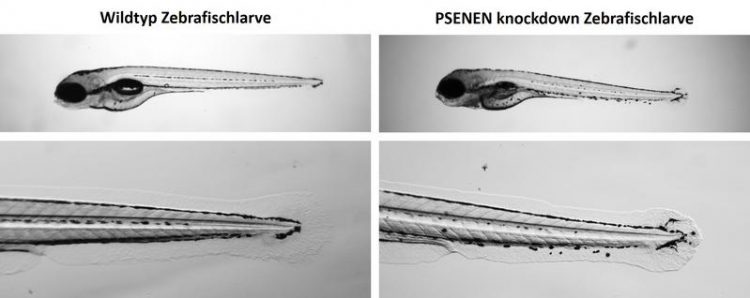Zebrafish without stripes

Microscopic image of zebrafish larvae: If the function of the PSENEN gene (right) was disrupted, the pigment cells (black) collected in unusual places to form clearly visible patches. (c) AG Betz / Universität Bonn
People with Dowling-Degos disease have a noticeably large number of dark pigment spots. These are frequently found in certain areas of the body, such as the face, neck, torso, hands, and the bending folds of the arms and legs. The pigmentation disorder generally progresses harmlessly; however, it can have a negative aesthetic effect.
Occasionally, those affected also develop extremely unpleasant skin inflammation, called acne inversa. This is not only painful but is also associated with festering blisters that can leave scars when they burst. The colonization of microorganisms on the affected areas of skin also creates unpleasant body odor. Acne inversa has a chronic progression; a permanent solution is only provided by surgery.
“We have genetically examined 90 people with Dowling-Degos disease since 2005,” explains Prof. Regina Betz from the Institute of Human Genetics at the University Hospital of Bonn. “Six of them also suffered from acne inversa.” The scientists found a special characteristic in this subgroup: the patients displayed mutations in what is known as the PSENEN gene.
It has been known that PSENEN mutations can cause acne inversa. “However, we were able to show for the first time that changes in this gene primarily cause Dowling-Degos disease and around half of the mutation carriers develop acne inversa,” emphasizes Damian Ralser, who is currently working on his doctorate at the Institute of Human Genetics.
To do this, the scientists used an animal that should be known to many aquarium enthusiasts due to its striking pigmentation: the zebrafish. However, the characteristic blueish black stripes, which give the fish its name, only form over time. The eyelash-sized zebrafish larvae are more or less transparent.
Fish as a model organism
Many processes in the body can thus be observed easily under an optical microscope. For this reason, the zebrafish is now used as a model organism by scientists around the globe. At the University of Bonn, Prof. Benjamin Odermatt from the Anatomical Institute is researching how zebrafish repair defective nerve tissue.
Zebrafish also have the PSENEN gene. “In order to be able to research more closely what effect PSENEN has, we, in collaboration with Prof. Odermatt, deactivated the gene in some zebrafish larvae and then compared these with normal larvae under the microscope,” explains Damian Ralser.
The pigment cells – the melanocytes – usually wander in a certain direction in the zebrafish larvae. This ensures that the characteristic striped pattern develops over time. However, the pigment cells wandered back and forth aimlessly in animals in which the functioning of PSENEN was disrupted. They ultimately collected in unusual places to form clearly visible patches – similar to people with Dowling-Degos disease.
Only a small proportion of all Dowling-Degos patients carry a PSENEN mutation. “There are also other disease genes that lead to the pigmentation disorder,” says Betz. She recommend that all those affected undergo testing. If a disrupted PSENEN gene is the actual cause, there is a significantly increased risk of also suffering from acne inversa. However, the scientist emphasizes that no one is exposed to this risk without protection: “This severe form of acne develops in particular in PSENEN mutation carriers who smoke a lot or who are overweight.”
Publication: Damian Ralser et al.: Mutations in gamma-secretase subunit–encoding PSENEN underlie Dowling-Degos disease associated with acne inversa; Journal of Clinical Investigation; DOI: 10.1172/JCI90667
Contact:
Prof. Regina Betz
Institute of Human Genetics
University of Bonn
Tel. +49 (0)228/28751023
E-mail: regina.betz@uni-bonn.de
Prof. Benjamin Odermatt
Anatomical Institute
University of Bonn
Tel. +49 (0)228/739021
E-mail: b.odermatt@uni-bonn.de
Media Contact
More Information:
http://www.uni-bonn.deAll latest news from the category: Health and Medicine
This subject area encompasses research and studies in the field of human medicine.
Among the wide-ranging list of topics covered here are anesthesiology, anatomy, surgery, human genetics, hygiene and environmental medicine, internal medicine, neurology, pharmacology, physiology, urology and dental medicine.
Newest articles

A new puzzle piece for string theory research
Dr. Ksenia Fedosova from the Cluster of Excellence Mathematics Münster, along with an international research team, has proven a conjecture in string theory that physicists had proposed regarding certain equations….

Climate change can cause stress in herring larvae
The occurrence of multiple stressors undermines the acclimatisation strategies of juvenile herring: If larvae are exposed to several stress factors at the same time, their ability to respond to these…

Making high-yielding rice affordable and sustainable
Plant biologists show how two genes work together to trigger embryo formation in rice. Rice is a staple food crop for more than half the world’s population, but most farmers…



